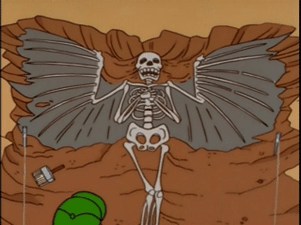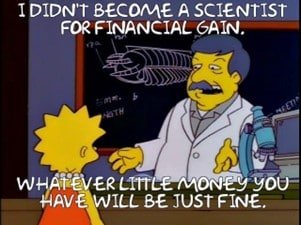Throughout its unending life, The Simpsons has made skepticism an integral part of 8-year-old Lisa Simpson’s identity, a hallmark being Season 9’s “Lisa the Skeptic” which aired exactly 25 years ago today. I was 8 when it aired, and while I didn’t fully appreciate it at the time, I do now. Even today, mass media in the United States toes a careful line when it comes to criticism of religion. But the sensation that was The Simpsons made a main character not just critical of religion, but often unambiguously right.
The first eight seasons featured plenty of religious satire, in episodes like “Homer the Heretic” (in which Homer founds his own religion to get out of going to church), “Bart After Dark” (which satirises moral panics), and “Bart Sells His Soul” (in which Bart sells his soul). And Lisa had uncovered myths about the town’s founder (“Lisa the Iconoclast”) and disproved a purported alien sighting (“The Springfield Files”). However, “Lisa the Skeptic” was the fist direct clash between Springfield’s religiosity and Lisa’s inquisitive nature. It grappled with religious intolerance, corporate greed, and good ol’ American separation of church and state (or lack thereof), all while providing no end of memorable quotes (“everyone knows leprechauns are extinct”).

After Lisa objects to construction of a mall on a site where many fossils had been discovered, the developers agree to undertake a survey to verify if there’s anything left to uncover. Lisa excavates what appears to be a human skeleton with two legs, two arms, and two wings emanating from the shoulders. Dr Hibbert helpfully clarifies: “from a strictly medical point of view, that ain’t right”.
The viewer may already be thinking of famous hoaxes like the Piltdown man or the Cardiff Giant, but the town conclude it’s the skeleton of an angel. While arguing about who should get to keep it (no one suggests a museum), Homer, of course, steals it. Initially just to hoard it for himself, but then to charge money to see it.
Lisa takes a sample for analysis to the late Stephen Jay Gould (the famed evolutionary biologist voices himself). When he comes by the next day only to say the tests aren’t finished, Reverend Lovejoy declares “science has faltered once again in the face of overwhelming religious evidence.” An anti-science mob attacks museums and research centres, prompting Lisa to try to destroy the angel, only to find that it has vanished. Lisa is arrested and put on trial, but is released when the angel is found sitting on a hill, now with the words “The End Will Come At Sundown” carved into the rock below its feet.
The townsfolk gather around that night, while Lisa reads Scientific American, and the angel is lifted up while a voice declares “the end… of high prices!” The now-completed mall is then illuminated. The entire affair is revealed as a publicity stunt, thought up by the developers when Lisa had the temerity to defend archaeology.

Important to note is that not everyone who believed in the angel was portrayed negatively. Marge tries to explain to Lisa why her faith is important, even as she disapproves of Homer’s grifting and of Springfield’s mob mentality. The episode frames Marge as wrong, but never stupid or corrupt. Mage has faith, but is still a thoughtful, intelligent, good person.
Lisa’s frustration was, to me, palpable. Even as a child, or perhaps especially as a child, I understood what it was like to know something, but not know how to communicate it. Lisa was right, but she didn’t know how to explain it, and Marge therefore defaulted to the beliefs she was raised with. Frustrating, but since Marge wasn’t trying to force Lisa to believe, like the rest of the town was, she wasn’t unsympathetic.
A similar plot would occur in season 17’s “The Monkey Suit”, in which the town decides to teach creationism in public school, after pressure from a mix of true believers and those who think the controversy is a profitable exploit. Lisa, again, is the voice of reason. This time, however, Marge comes to her side in part by reading On the Origin of Species for herself. In the real world, not everyone accepts evidence when its presented to them, for all sorts of reasons. Marge sought out evidence because she valued her daughter and wanted to listen.
The series doesn’t always hit the mark on issues of science, skepticism, and religion. For every satire of religion like “Lisa the Skeptic” or veiled parody of Scientology like “The Joy of Sect”, there’s awkward anti-GMO messaging in “Weekend at Burnsie’s”. Or there’s “The Man Who Grew Too Much”, which begins with a measured pushback against uncritical anti-GMO panics, but then segué’s into uncritical support of privatised corporate control of GMOs while also grossly misrepresenting how genetic modification works.
But very often the show aims to encourage freedom of thought, critical thinking, and tolerance. Take the season 34 premier from this September, “Habeas Tortoise”. Homer seeks out a community online after feeling shunned and isolated in the real world. The group he built spiralled into conspiracy theories, reinforcing every bad idea as a way of building community. Some of them turned toward violence because there was little checking their impulses.
Of course, this framework suggests that isolated people seeking validation are the only ones who get roped into conspiracies, and that they come up with them independently. This ignores how many conspiracy theories are built off pre-existing ideas, how many people leave their existing community in favour of conspiratorial ones, and how often grifters who know better encourage escalation— all of which are well demonstrated by QAnon, an amalgam of pre-existing conspiracies and prejudices, used as a money-maker by the likes of InfoWars. Which ties back nicely with “Lisa the Skeptic”, with both Homer and the mall developers provoking the mob for their own gains.
I was 8 years old when “Lisa the Skeptic” first aired. I didn’t know who Stephen Jay Gould was, I didn’t know what skepticism was, I didn’t know about archaeological hoaxes. It’s hard to say how much influence any one work of fiction had on my development, but one reason that characters like Lisa appealed to me was that I was raised in a household that promoted critical thinking and appreciation of science.

Whichever the direction of causality, child-me had a connection with the Simpsons’ irreverent approach to religion and groupthink. And for all its faults, it’s been fun seeing positive examples of critical thinking in a massively popular media franchise over the years.
And if you’re wondering why testing never showed the bones were fake, Gould explains that he “never did the tests” before walking off to the mall.
Rest in peace, Dr Gould.



